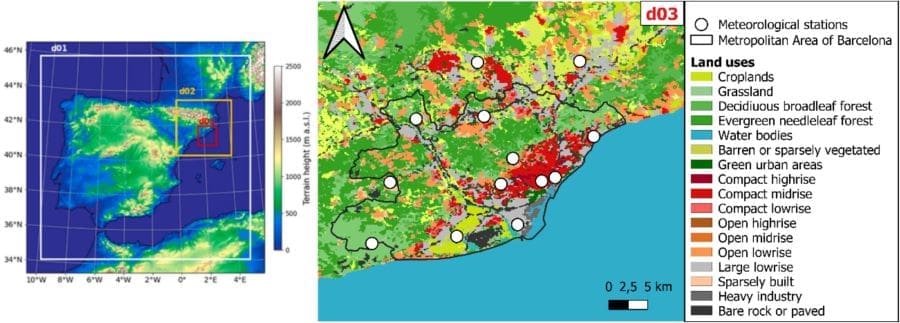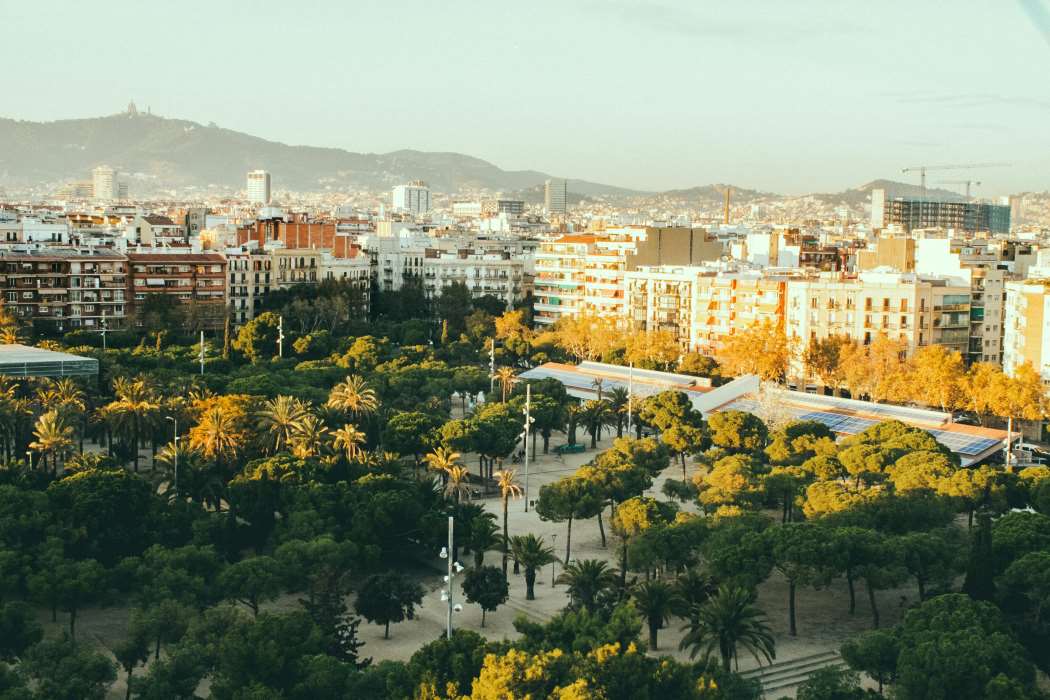Summary:
Expanding green spaces in Barcelona by converting every third street into a green corridor could help prevent up to 178 premature deaths per year, according to a study by the Barcelona Institute for Global Health (ISGlobal).
The research, published in Environment International, estimates that increasing vegetation cover would not only reduce overall mortality but also lower the risk of heat-related deaths during extreme summer temperatures. By modeling the effects of the city’s Green Corridors plan, researchers found that a 3.64% increase in green space — from 7.3% in 2019 to 10.9% — would have significant health benefits.
Additionally, the study projects that such greening efforts could lead to a slight temperature reduction, preventing an estimated five additional deaths during heat waves. The analysis also considered the Metropolitan Urban Master Plan (PDUM), which aims to increase green areas by 2030, though its health benefits were found to be more limited due to uneven distribution.
Researchers emphasize that beyond mortality reduction, expanding urban greenery could offer further advantages, such as lower air pollution and increased physical activity, making it a crucial tool for healthier cities.

Improving the Distribution of Green Spaces in Barcelona Could Prevent 178 Premature Deaths Each Year
Greening every third street in the city of Barcelona could potentially prevent up to 178 premature deaths each year. In addition, in months when heat waves occur, urban trees and gardens would help prevent another five temperature-related deaths. These are the main conclusions of a health impact study carried out by the Barcelona Institute for Global Health (ISGlobal), a centre supported by the ’la Caixa’ Foundation.
Methodology
It is well known that green spaces are associated with a number of benefits for physical and mental health and well-being, including a decrease in premature mortality. In addition, urban trees and vegetation provide areas of shade and help combat the effects of urban heat islands.
For this reason, a team from ISGlobal set out to estimate the effects that the comprehensive implementation of the Green Corridors plan would have on the mortality of Barcelona’s adult population in relation to two variables: the percentage of the urban surface area dedicated to green spaces and the ambient temperature. In its theoretical formulation, the Green Corridors plan envisioned that every third street in the city would become a green corridor.
The team took 2019 as a reference year prior to a hypothetical implementation of the plan. Subsequently, they obtained the mortality data for that year and for the city of Barcelona from two sources: the Statistical Institute of Catalonia (IDESCAT) and the National Statistics Institute (INE). The percentage of green space in the city was obtained from specific maps from the European Environment Agency (EEA).
According to the forecasts described in the Green Corridors project itself, they estimated that the intervention would lead to an increase of 7% or 15% in the green surface area of each street or intersection, depending on their width.
Finally, to estimate the number of preventable deaths as a result of the planned increases in green space, they used previous scientific studies that quantified this relationship.
3.64% increase in green space
The results show that the creation of green corridors throughout the city would mean a 3.64% increase in the area devoted to green spaces, going from the 7.3% that there was in 2019 to 10.9%. This increase would have the potential to prevent 178 premature deaths a year, or what is the same: 13 deaths per 100,000 inhabitants.
“Barcelona is a compact city with a challenge when it comes to green spaces: it has a small area allocated for this purpose and, moreover, what little it has is poorly distributed, as it is mainly located on the outskirts,” explains Tamara Iungman, ISGlobal researcher and first author of the study. “Although the increase in green spaces that we estimate is modest in percentage terms, as it does not reach 4% and the city would still be far from the 25% recommended, its impact in terms of health is significant. This is because the Green Corridors plan provided for an equitable distribution of these spaces throughout the city,” she adds.
Five heat-related deaths would be avoided
At the same time, the team carried out a second health impact study, related to heat-related mortality. With the help of various models, they estimated that the expected increase in the area devoted to green spaces could result in a reduction in the average temperature of 0.05 ºC, reaching a reduction of 0.42 ºC in some parts of the city.
Once these figures had been obtained and using the relationship between temperature exposure and mortality established in previous scientific studies, they estimated that in a hypothetical Barcelona with green corridors, five deaths per month could be avoided in high temperature situations such as those recorded in the summer month of 2015, which was taken as a reference. This is equivalent to one death every six days.
“Although the impact of the Green Corridors on temperatures would not be negligible, it is clear that complementary measures would be needed specifically aimed at combating the heat and adapting to it. This is especially relevant in a context of climate change and an ageing population that is becoming more vulnerable to the effects of high temperatures,” warns Tamara Iungman.
Deaths preventable with the Metropolitan Urban Master Plan (PDUM)
Given that the Green Corridors plan was postponed, the team decided to analyse an alternative: the Metropolitan Urban Master Plan (PDUM) of the Barcelona Metropolitan Area (AMB), which has among its objectives to increase the area allocated to green spaces by the year 2030. Following the same methodology as in the previous steps, it was calculated that the increase in green spaces foreseen in this plan could prevent 53 premature deaths per year in the city of Barcelona, that is, 4 deaths per 100,000 inhabitants.
In terms of temperature, the PDUM would achieve an average reduction of 0.03 ºC, although with a maximum reduction of 0.77 ºC in a specific area of the city. This temperature decrease would prevent 3 deaths per month in temperature situations such as the one used as a reference.
“In our analysis we observed that the PDUM would obtain more limited health benefits than the green corridors. This can be explained by the fact that the interventions contemplated in the PDUM are more localised and are not distributed equitably throughout the city, so that only the people who live closest to those points could benefit from them,” says Mark Nieuwenhuijsen, director of the Climate, Air Pollution, Nature and Urban Health programme at ISGlobal.
“It should be borne in mind that in this study we have only considered the direct relationship between green spaces and mortality. Any urban planning intervention that proposes to increase the area allocated to green spaces would not only be expected to reduce the burden of disease, but also to provide additional benefits associated with a reduction in air and noise pollution and an increase in levels of physical activity,” adds Nieuwenhuijsen.
Currently, ISGlobal’s scientific team is conducting a study with the same methodology to assess the impact on mortality of the Green Roofs project, an initiative of the current City Council that proposes the greening of roofs.
Journal Reference:
Tamara Iungman, Sergi Ventura Caballé, Ricard Segura-Barrero, Marta Cirach, Natalie Mueller, Carolyn Daher, Gara Villalba, Evelise Pereira Barboza, Mark Nieuwenhuijsen, ‘Co-benefits of nature-based solutions: A health impact assessment of the Barcelona Green Corridor (Eixos Verds) plan’, Environment International 196, 109313 (2025). DOI: 10.1016/j.envint.2025.109313
Article Source:
Press Release/Material by Barcelona Institute for Global Health (ISGlobal)
Featured image credit: Regina Pivetta | Pexels




